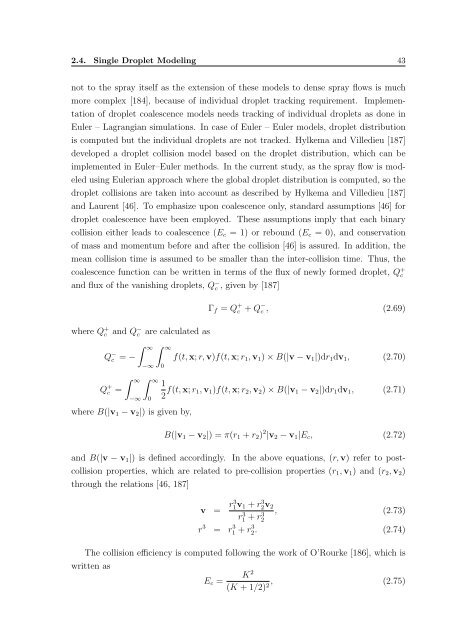INAUGURAL–DISSERTATION zur Erlangung der Doktorwürde der ...
INAUGURAL–DISSERTATION zur Erlangung der Doktorwürde der ...
INAUGURAL–DISSERTATION zur Erlangung der Doktorwürde der ...
Create successful ePaper yourself
Turn your PDF publications into a flip-book with our unique Google optimized e-Paper software.
2.4. Single Droplet Modeling 43<br />
not to the spray itself as the extension of these models to dense spray flows is much<br />
more complex [184], because of individual droplet tracking requirement. Implementation<br />
of droplet coalescence models needs tracking of individual droplets as done in<br />
Euler – Lagrangian simulations. In case of Euler – Euler models, droplet distribution<br />
is computed but the individual droplets are not tracked. Hylkema and Villedieu [187]<br />
developed a droplet collision model based on the droplet distribution, which can be<br />
implemented in Euler–Euler methods. In the current study, as the spray flow is modeled<br />
using Eulerian approach where the global droplet distribution is computed, so the<br />
droplet collisions are taken into account as described by Hylkema and Villedieu [187]<br />
and Laurent [46]. To emphasize upon coalescence only, standard assumptions [46] for<br />
droplet coalescence have been employed. These assumptions imply that each binary<br />
collision either leads to coalescence (E c = 1) or rebound (E c = 0), and conservation<br />
of mass and momentum before and after the collision [46] is assured. In addition, the<br />
mean collision time is assumed to be smaller than the inter-collision time. Thus, the<br />
coalescence function can be written in terms of the flux of newly formed droplet, Q + c<br />
and flux of the vanishing droplets, Q − c , given by [187]<br />
Γ f = Q + c + Q − c , (2.69)<br />
where Q + c and Q − c are calculated as<br />
Q − c<br />
∫ ∞<br />
= −<br />
−∞<br />
∫ ∞<br />
0<br />
f(t, x; r, v)f(t, x; r 1 , v 1 ) × B(|v − v 1 |)dr 1 dv 1 , (2.70)<br />
Q + c =<br />
∫ ∞ ∫ ∞<br />
−∞<br />
where B(|v 1 − v 2 |) is given by,<br />
0<br />
1<br />
2 f(t, x; r 1, v 1 )f(t, x; r 2 , v 2 ) × B(|v 1 − v 2 |)dr 1 dv 1 , (2.71)<br />
B(|v 1 − v 2 |) = π(r 1 + r 2 ) 2 |v 2 − v 1 |E c , (2.72)<br />
and B(|v − v 1 |) is defined accordingly. In the above equations, (r, v) refer to postcollision<br />
properties, which are related to pre-collision properties (r 1 , v 1 ) and (r 2 , v 2 )<br />
through the relations [46, 187]<br />
v = r3 1v 1 + r2v 3 2<br />
, (2.73)<br />
r1 3 + r2<br />
3<br />
r 3 = r1 3 + r2. 3 (2.74)<br />
The collision efficiency is computed following the work of O’Rourke [186], which is<br />
written as<br />
E c =<br />
K 2<br />
(K + 1/2) 2 , (2.75)













